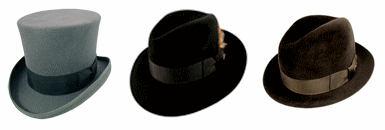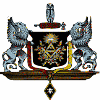Masonic Hats
Postado Quarta-feira, 05 Janeiro, 2011 as 1:06 AM pelo Ir:. Angelo Andres Maurin Cortes
Do You Have To Wear A Master's Hat?
Top Hat Black Stetson Fedora Brown Fedora

Masonic hats worn by the Master of the Lodge signify his authority of his rank and status...the origins of which go back over many centuries. The wearing of a hat by the Worshipful Master alludes to the crown that adorned the head of King Solomon.
In the United States, a Stetson fedora is quite popular and is often chosen by the Master of the lodge. Other hat brands are also worn.
Albert Mackey, Masonic researcher and historian had this to say about Masonic hats:
To uncover the head in the presence of their superiors has been, among Christian nations, held as a dutiful obligation.
Among Eastern nations, it is their custom to uncover their feet when they enter a place of worship.
Kings:
Historically, Kings wore crowns to denote their rank, while the courtiers standing around him removed their hats in deference to his superior status.
Ancient Romans
We are told that the ancient Romans prayed with their head covered or veiled.
The woolen cap, called a pileus, was allowed to be worn only by the free-by-birth or manumission (papers with which one is formally released from slavery), but it was forbidden for Roman slaves to wear this cap.
House of Commons - London
Historically, it was customary that a member of the English Parliament, London's House of Commons, wear a hat when he addressed the membership of the House. If he were to have risen to speak without his hat, other members would greet him with cries of "Order, Order"!
France
In France, it was the custom of monks at the Sorbonne, (previously called the University of Paris which was founded in 1257 by Robert de Sorbon) to remove their cap when a member did not wish to speak or was in token of agreement with the others.
(End of Mackey quote from Mackey's Encyclopedia of Freemasonry, 1929)
Masonic Hats:
United States:
Today, Masonic hats are worn, ceremonially, in the United States during the time when the lodge is in session. Some Grand Lodges require that the hat be constructed with a brim. Others simply decree that the Worshipful Master remains covered at all times.
Internationally:
In different jurisdictions around the world, it is also common to see many different styles of Masonic hats.
Worshipful Master Hat:
Q: Does the Worshipful Master have to wear a Masonic hat?
A: No. Masonic hats are the privilege of the Master of the Lodge, and only his. To remain with his head covered to signify that his is the position to which the greatest respect should be paid. If in doubt, however, contact your Grand Lodge for more information about your specific jurisdiction.
The Worshipful Master of a Lodge holds the most honored, prestigious and sacredly held chair of office during his term.
The Worshipful Master's Position is one of the 3 Lesser Lights
The 3 Lesser Lights of a Lodge are the Sun, the Moon and the Worshipful Master.
As the highest ranking officer within the lodge; it is the duty of the man holding this office to preserve the solemnity and respect of this ancient and historic position, symbolic of his duties as one of the Lesser Lights.
While Masonic hats differ within jurisdictions around the world, Masonic hats are a visible symbol of the Master's authority, and as such, should reflect a respectful, classic or traditional style.
Hat Tips:
Here are 7 hat tips to keep your Master's hat in tip-top condition:
1. Wet Hat:
If your felt hat gets wet, first return the hat to its original shape. Then, turn the interior leather sweatband down and rest the hat on its sweatband to dry.
Avoid resting the hat on its’ brim while wet, as this may matte down the felt or other material of construction.
2. Hatbands Shrink:
Heat will shrink the interior sweatband of Masonic hats.
While it's tempting to put a wet hat on a heat source such as a lamp, radiator or, especially in the car window ....please don't.
It will dry too fast and then be too tight and give you a headache the next time you wear it.
3. Removing Your Hat:
Never rest your hat on its' brim. Turn it upside down and rest it on the crown.
Resting a hat on its brim will flatten-out the brim resulting in a wider, less classic look and you'll continually be trying to re-bend the brim back into shape.
4. Proper Hat Handling :
Proper handling will extend the life of your hat.
Never touch the hat with dirty, oily hands or gloves.
Pick up the hat from the underneath by both the front and back brim (not the sides) to maintain the shape and set of the brim.
5. Hat protectors:
Hat protectors are seldom thought about when purchasing Masonic hats, but as Worshipful Master, remember,...you may very well be called upon to attend a Masonic funeral when it is raining, snowing or sleeting.
6. Hat Cans:
Hat cans save your hat from dirt and help it to keep its original shape.
The inner hat rest can be adjusted to fit any hat size by simply adjusting the wingnuts beneath the hat rest.
It can be a lifesaver, too, if you forget and leave your hat on the car seat...and then pick up the kids, grandkids, the dog or anything else that will soon have you back in the market.... buying a new hat.
7. Hat Stretchers:
If your hat does get wet and shrinks, there are also Hat Jack Stretchers to help you re-size it.


